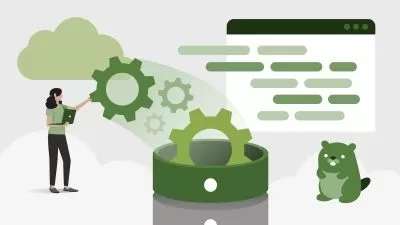100 Go Mistakes and How to Avoid Them Video Edition
Focused View
12:37:31
209 View
001. Chapter 1. Go Simple to learn but hard to master.mp4
08:22
002. Chapter 1. 100 Go mistakes.mp4
09:54
003. Chapter 2. Code and project organization.mp4
08:16
004. Chapter 2. 3 Misusing init functions.mp4
11:03
005. Chapter 2. 5 Interface pollution.mp4
12:13
006. Chapter 2. Interface pollution.mp4
08:15
007. Chapter 2. 7 Returning interfaces.mp4
08:16
008. Chapter 2. 9 Being confused about when to use generics.mp4
10:10
009. Chapter 2. 10 Not being aware of the possible problems with type embedding.mp4
07:02
010. Chapter 2. 11 Not using the functional options pattern.mp4
10:41
011. Chapter 2. 12 Project misorganization.mp4
11:19
012. Chapter 2. 14 Ignoring package name collisions.mp4
06:27
013. Chapter 2. 16 Not using linters.mp4
07:02
014. Chapter 3. Data types.mp4
11:41
015. Chapter 3. 19 Not understanding floating points.mp4
08:45
016. Chapter 3. 20 Not understanding slice length and capacity.mp4
07:44
017. Chapter 3. 21 Inefficient slice initialization.mp4
05:56
018. Chapter 3. 22 Being confused about nil vs. empty slices.mp4
10:24
019. Chapter 3. 24 Not making slice copies correctly.mp4
07:59
020. Chapter 3. 26 Slices and memory leaks.mp4
09:07
021. Chapter 3. 27 Inefficient map initialization.mp4
06:29
022. Chapter 3. 28 Maps and memory leaks.mp4
06:37
023. Chapter 3. 29 Comparing values incorrectly.mp4
11:20
024. Chapter 4. Control structures.mp4
07:39
025. Chapter 4. 31 Ignoring how arguments are evaluated in range loops.mp4
06:15
026. Chapter 4. 32 Ignoring the impact of using pointer elements in range loops.mp4
09:35
027. Chapter 4. Map insert during iteration.mp4
11:20
028. Chapter 5. Strings.mp4
07:28
029. Chapter 5. 37 Inaccurate string iteration.mp4
09:09
030. Chapter 5. 39 Under-optimized string concatenation.mp4
10:12
031. Chapter 5. 41 Substrings and memory leaks.mp4
07:08
032. Chapter 6. Functions and methods.mp4
07:07
033. Chapter 6. 43 Never using named result parameters.mp4
09:30
034. Chapter 6. 45 Returning a nil receiver.mp4
10:00
035. Chapter 6. 47 Ignoring how defer arguments and receivers are evaluated.mp4
08:44
036. Chapter 7. Error management.mp4
12:04
037. Chapter 7. 50 Checking an error type inaccurately.mp4
09:33
038. Chapter 7. 52 Handling an error twice.mp4
06:31
039. Chapter 7. 54 Not handling defer errors.mp4
07:32
040. Chapter 8. Concurrency Foundations.mp4
06:14
041. Chapter 8. 56 Thinking concurrency is always faster.mp4
08:31
042. Chapter 8. Parallel merge sort.mp4
12:18
043. Chapter 8. 58 Not understanding race problems.mp4
09:48
044. Chapter 8. The Go memory model.mp4
07:26
045. Chapter 8. 59 Not understanding the concurrency impacts of a workload type.mp4
07:43
046. Chapter 8. 60 Misunderstanding Go contexts.mp4
09:51
047. Chapter 8. Catching a context cancellation.mp4
06:58
048. Chapter 9. Concurrency Practice.mp4
11:08
049. Chapter 9. 63 Not being careful with goroutines and loop variables.mp4
11:55
050. Chapter 9. 65 Not using notification channels.mp4
12:02
051. Chapter 9. 67 Being puzzled about channel size.mp4
07:05
052. Chapter 9. 68 Forgetting about possible side effects with string formatting.mp4
12:00
053. Chapter 9. 70 Using mutexes inaccurately with slices and maps.mp4
10:09
054. Chapter 9. 72 Forgetting about sync.Cond.mp4
09:34
055. Chapter 9. 73 Not using errgroup.mp4
06:26
056. Chapter 9. 74 Copying a sync type.mp4
06:42
057. Chapter 10. The standard library.mp4
09:22
058. Chapter 10. 77 Common JSON-handling mistakes.mp4
11:27
059. Chapter 10. 78 Common SQL mistakes.mp4
11:46
060. Chapter 10. 79 Not closing transient resources.mp4
10:02
061. Chapter 10. 80 Forgetting the return statement after replying to an HTTP request.mp4
08:49
062. Chapter 10. HTTP server.mp4
07:28
063. Chapter 11. Testing.mp4
08:43
064. Chapter 11. 83 Not enabling the -race flag.mp4
09:39
065. Chapter 11. 85 Not using table-driven tests.mp4
11:08
066. Chapter 11. 87 Not dealing with the time API efficiently.mp4
06:56
067. Chapter 11. 88 Not using testing utility packages.mp4
08:52
068. Chapter 11. 89 Writing inaccurate benchmarks.mp4
08:39
069. Chapter 11. Not being careful about compiler optimizations.mp4
09:09
070. Chapter 11.9 90 Not exploring all the Go testing features.mp4
10:14
071. Chapter 12. Optimizations.mp4
11:26
072. Chapter 12. Slice of structs vs. struct of slices.mp4
06:50
073. Chapter 12. Cache placement policy.mp4
10:52
074. Chapter 12. 92 Writing concurrent code that leads to false sharing.mp4
06:46
075. Chapter 12. 93 Not taking into account instruction-level parallelism.mp4
09:56
076. Chapter 12. 94 Not being aware of data alignment.mp4
08:16
077. Chapter 12. 95 Not understanding stack vs. heap.mp4
12:04
078. Chapter 12. 96 Not knowing how to reduce allocations.mp4
08:39
079. Chapter 12. 97 Not relying on inlining Part 1.mp4
07:52
080. Chapter 12. 97 Not relying on inlining Part 2.mp4
10:19
081. Chapter 12. 97 Not relying on inlining Part 3.mp4
11:17
082. Chapter 12. 99 Not understanding how the GC works.mp4
09:55
083. Chapter 12. 100 Not understanding the impacts of running Go in Docker and Kubernetes.mp4
10:26
More details
User Reviews
Rating
average 0
Focused display
Category

O'Reilly
View courses O'ReillyO'Reilly Media is an American learning company established by Tim O'Reilly that publishes books, produces tech conferences, and provides an online learning platform. Its distinctive brand features a woodcut of an animal on many of its book covers.
- language english
- Training sessions 83
- duration 12:37:31
- Release Date 2023/03/27










